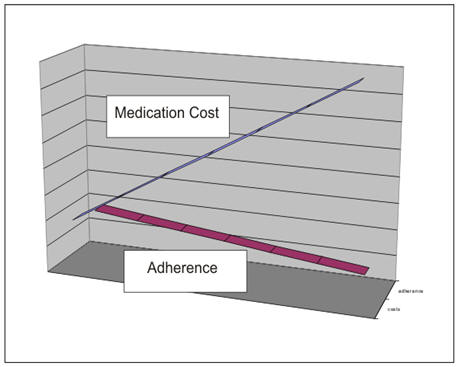 Instructions
Instructions
 Take Another Course
Take Another Course
 Post-Test
Post-Test
|
Trendgraph Analysis Reveals
Cost of treating
complications
Costs can dictate
compliance to medication and preventive
screening
|
|
Let’s
take a look at reimbursement…
The estimated cost of treating complications
of diabetes in 2006 was $22.9 billion in the
United States, with an average of $10
thousand per patient and about $1,600 in out
of pocket expenses per patient. Diabetic
patients have more than twice the medical
costs than non-diabetic patients. Costs for
the care of diabetes in the United States
related to complications have increased
dramatically in the last decade.
Patients who are less likely to be covered
include African American, Hispanic and those
who report low incomes. Uninsured patients
are less likely to get annual exams for
sight, feet, or HbA1c, and were less likely
to practice SMBG.[iii]
A group of researchers in Sweden developed a
predictive model to determine costs
associated with prevention of diabetes and
related cardiovascular events. They
attempted to reduce lifestyle-related risks
to find that not only was there an expected
increase in survival, which may otherwise
have increased costs for care, the overall
lifetime cost savings were more than €2300,
or roughly $3,550 at current exchange rates.[iv]
|
 |
|
Medicare
A large percentage of patients with diabetes
rely on Medicare to pay for their healthcare
costs. Moreover, many insurance companies
follow Medicare’s coverage criteria. The
impact of coverage is significant. For
instance, nearly a third of diabetes
patients have made decisions to not take a
medication based on Medicare coverage for
costs and other financial issues.[v]
This can lead to additional complications
and cost burdens to the health care system.
Medicare currently covers up to two
screenings as a fasting plasma glucose test
free of cost each year for Medicare-enrolled
patients who demonstrate risk through
hypertension, dyslipidemia, obesity, and/or
a history of high blood sugar. Patients who
are diagnosed with diabetes receive coverage
for self management training and supplies
(monitor, test strips, lancets) at a level
of 80% once the yearly Part B deductible is
reached.[vi]
HbA1c tests are covered if it is ordered by
a doctor. Glaucoma tests are covered on a
once-yearly basis. For medications to
control blood sugar, there may be a
deductible to fulfill before coverage is
activated. A copayment may then be required.
Insulin pumps may be covered under Medicare
Part B, and specific medications coverage
can be explored using the Medicare website (www.medicare.gov).
Medical nutrition therapy is covered by
Medicare Part B with copayments and/or
coinsurance once Part B deductibles are
reached. Other therapies, such as
therapeutic shoes or inserts for patients
with diabetes-related foot disease are also
covered for the approved amount after
deductible and copayment.
Special assistance is available for
low-income patients through a State Health
Insurance Assistance Program (or SHIP). In
addition, some states have State Pharmacy
Assistance Programs (or SPAP) to help in
paying for medications. Phone numbers are
available on the Medicare website, as is a
booklet explaining Medicare coverage for
diabetes. |
|
Coverage-based compliance issues
Medicare coverage
guidelines
Two
screenings per year in patients with
high risk
Self
management training and supplies
Routine
testing if ordered by doctor
Medications
and pumps vary
Special
assistance available for low-income
patients
|
Commercial Insurance
Medicare Advantage Plans (Part C) are administered
by private insurance companies to cover typical
Medicare-covered costs as well as offer some
additional coverage. Other private insurance plans
may vary widely in their coverage and are subject to
state laws. Currently, 46 states have laws mandating
diabetes health coverage. Descriptions of
state-by-state coverage is shown on the first
website listed below.[i]
In New York, a diabetes insurance law became
effective in January 1994 and provided coverage for
medically necessary education and
equipment/supplies. The law defines who can provide
education and prescribe treatment, which prescribed
supplies should be covered, and who the law applies
to (such as Health Maintenance Organizations,
Medicaid recipients, and others). States without
such laws are Alabama, Idaho, Ohio, and North
Dakota.
Employer-supported group health insurance cannot
turn away diabetes patients, but individual health
care insurance may not be subject to the same laws.
In many states, “insurers of last resort” are
designated to insure patients who have been turned
down by other individual policies or have “high risk
pools” to offer insurance coverage when it is not
available elsewhere. State by state information is
available at the second website listed below.
|
Medicare Advantage Plans
Private insurance
Employer-supported group
health insurance
Insurers of last resort
|
|
|
 Instructions
Instructions


